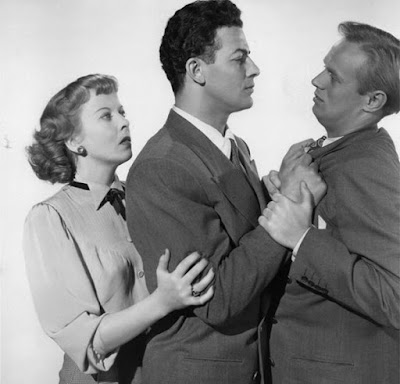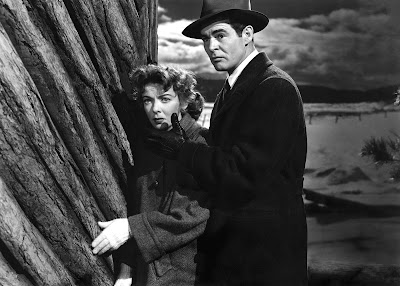Essential Cinema: IDA LUPINO: THE HARD WAY Series Notes

ESSENTIAL CINEMA: IDA LUPINO: THE HARD WAY
ON DANGEROUS GROUND: Thu, Aug 4, 2016, 7:30 PM, AFS Cinema
ROAD HOUSE: Thu, Aug 11, 2016, 7:30 PM, AFS Cinema
MOONTIDE: Wed, Aug 17, 2016, 7:30 PM, AFS Cinema
THE HITCHHIKER: Thu, Aug 25, 2016, 7:30 PM, AFS Cinema
The Lupino name has been synonymous with the theater for many centuries, from Renaissance Italy, where the Neapolitan Lupinos began the family tradition as strolling players, jugglers and dancers; continuing into the 17th century, when the already-well known clan was exiled to England for political reasons, and where they became popular as actors, acrobats and clowns; and, eventually, to both the legitimate stage and music halls of London.
Ida Lupino, born in 1918 during an air raid blackout in London, was brought up in a home that was part boarding house and part theatrical agency. Traveling artistes stayed there, rehearsals took place in front of the family hearth, and Ida received a complete education in acting, stagecraft and music before she even set off for school. The young prodigy even wrote, produced, and starred in a play at age seven.
Through her family connections – her father Stanley was a director, and her uncle, who went by the name Lupino Lane, was a popular comic – she made her screen debut in 1931 in one of her father’s films, THE LOVE RACE. The experience on the film set made her think more seriously of acting as a career so she applied to and was accepted by the prestigious Royal Academy of Dramatic Art (RADA). She acted in many plays there and honed her natural talent to a fine edge. Itinerant American director Allan Dwan was then making a film in London. He saw much in the lovely, poised young actress, whom he cast – over her mother, who was in fact auditioning for the part – in an important role in HER FIRST AFFAIRE (1932).
Word got out about the talented newcomer and Paramount Pictures sent a ticket and a contract for her, with the idea that she would be perfect at playing Alice In Wonderland. But when she screen-tested for Alice it became apparent that she was too mature-looking for the role. Stuck in Hollywood, and under contract, she was restyled with processed blonde hair and pencil eyebrows as “the new Jean Harlow” and given roles that were, to say the least, beneath her abilities. It was at this time that she told a friend, “If I don’t get a part that I can get my teeth into, I’m going back home.” This was the beginning of several years of discontent, during which she alternately refused roles, served suspensions, and was loaned out for, sometimes punitive, assignments for other studios. By 1937, she convinced Paramount to release her.
A free agent at age 19, Lupino stopped bleaching her hair, and allowed her eyebrows to grow in naturally. She composed music during this time, a longtime avocation, and had her symphonic piece “Aladdin’s Lamp” performed by the Los Angeles Philharmonic. She made few films and got married. At this time she easily could have decided that the cinema was not in her future but when she heard that William Wellman was making an adaptation of one of her favorite stories, THE LIGHT THAT FAILED (1939), she knew that the part (a vulgar cockney bar girl who models for a great painter’s last work as he loses his sight) was one she could play better than anyone else. She stormed into Wellman’s office and gave a thunderous impromptu audition that convinced him to cast her. It was a breakthrough performance.
Soon the 21 year old was known as an acting powerhouse, and one who could hold her own against a powerful male co-lead. Warner Brothers signed her to a contract where she made some of the best films of her career, including THEY DRIVE BY NIGHT (1940) with George Raft and Humphrey Bogart, HIGH SIERRA (1940) again with Bogart, and THE SEA WOLF (1941) with John Garfield and Edward G. Robinson. Here she again occasionally found herself on suspension, as when she refused a role in KING’S ROW alongside Ronald Reagan. During her suspensions she learned a great deal about the technical aspects of filmmaking, as she used the idle time to shadow directors, editors and cameramen.
When not on suspension, she was often on loan to other studios, which is how she ended up at Fox making MOONTIDE in 1942.
MOONTIDE
D. Archie Mayo & Fritz Lang (uncredited), 1941
Written by John O’Hara and Nunnally Johnson (uncredited) from the novel by Willard Robertson; With Ida Lupino, Jean Gabin, Thomas Mitchell, Claude Rains; Cinematography by Charles Clarke; Music by David Buttolph and Cyril Mockridge
Hitler’s rise to power brought many talented Europeans to Hollywood, including, improbably, the great French leading man Jean Gabin. Perhaps it was thought that Gabin, whose magnetic but rough-hewn charm made him a favorite in France, would be the next Charles Boyer, but the two Frenchmen were very different and Gabin would be considered a washout in Hollywood, which was just as well for the art of cinema as he went on to do much of his best work back home in France. Here Gabin is a pillar of strength as a longshoreman who thinks he may have committed a murder and therefore retreats from the world to a small dockside shack. There he rescues a young woman (Lupino) who tries to drown herself but they find an obstacle to their domestic bliss when his friend (Thomas Mitchell) develops designs on Lupino (or perhaps Gabin himself). It’s a beautiful, semi-noir art film. Original director Fritz Lang, nursing a candle for Marlene Dietrich, hated Gabin, who was Dietrich’s longtime beau, and contrived a successful plan to get fired from the film after three weeks. It still bears his stamp, as well as that of novelist/short story writer John O’Hara, whose ear for dialogue was almost peerless. Lupino is heartbreaking as the woman who finds a reason to live again thanks to unexpected love.
By the end of the ‘40s, Lupino was becoming more independent than ever. After leaving Warner Brothers at age 29, she again struck out on her own and made such films as the extraordinary, tough ROAD HOUSE (1948).
ROAD HOUSE
D. Jean Neguelsco, 1948
Written by Edward Chodorov; With Ida Lupino, Cornel Wilde, Richard Widmark, Celeste Holm; Cinematography by Joseph LaShelle; Music by Cyril Mockridge
By 1948, Ida Lupino was, by any standard, a master actor, with 15 years in Hollywood on top of her prodigious formal education. In a role like this one, as a woman of easy virtue who drives all the men wild at a sleazy rural nightclub, that technical polish and experience might seem extraneous – after all, couldn’t any actress with sex appeal play this part? Well, no. Not like this. Lupino takes this fastball for a long ride as she nails the tough dialogue with the precision of an Olivier. It’s the story of a rivalry between two old friends, Cornel Wilde, as the manager of the roadhouse, and Richard Widmark, as the nasty, spoiled rich kid who inherited the business. Lupino, as she was so often in real life, is independent, but she can’t keep her heart entirely out of it. She performs several songs, using her own smoky singing voice, and creates from this rough material a character you’ll never forget.
In 1949 Lupino, along with husband Collier Young, formed her own production company, The Filmmakers, to make quality, low budget, message films. Initially she was to be only a writer and producer, but when director Elmer Clifton had a mild heart attack during the filming of NOT WANTED (1949), Lupino finished the shoot. Through all this she continued her acting work, and in 1951 she gave one of her finest performances in Nicholas Ray’s ON DANGEROUS GROUND.
ON DANGEROUS GROUND
Nicholas Ray, USA, 1951, 35mm, 82 min
Written by A.I. Bezzerides from the novel by Gerard Butler; With Ida Lupino, Robert Ryan, Ward Bond; Cinematography by George E. Diskant; Music by Bernard Herrmann
Many viewers consider Nicholas Ray’s ON DANGEROUS GROUND to be a “schizophrenic” film, with two distinct sections – the first focusing on out-of-control tough cop Robert Ryan’s experiences on the streets among the amoral scum of the big city, and the second depicting a more pastoral-looking, but no less secure, rural setting. This was intentional. In fact, Ray wanted to film the first chapter in black and white, and the rest in color a la WIZARD OF OZ. In this film, which Lupino directed a few days of, uncredited, she plays the blind sister of a fugitive boy who Ryan, with the victim’s unhinged father in tow, is assigned to catch. Through the woman’s example, Ryan, whose moral compass had been spinning wildly out of control, finds his north star, but not before fate can play its hand. It was common practice for actors, when playing blind characters, to wear special contacts, but Lupino insisted on “acting” blind, that is, without special assistance, and it’s certainly effective. Like all of Ray’s idiosyncratic films, the external settings mirror inner conflicts to an almost baroque degree. This film was neither a critical or commercial success upon release but has come to be highly regarded by modern audiences.
Lupino used acting to fund her productions, and continued to make her own films, including the first film noir ever directed by a woman, THE HITCHHIKER.
THE HITCHHIKER
Ida Lupino, USA, 1953, 35mm, 71 min
Written by Ida Lupino and Collier Young; With Edmond O’Brien, Frank Lovejoy, William Talman; Cinematography by Nicolas Musuraca; Music by Leith Stevens
Many auteurists despair of Lupino’s directorial work. All the lessons and connections they would seemingly like to find in her work are tantalizingly absent or brief. She was, as she liked to point out, “the poor man’s Don Siegel”, in other words, a pro’s pro, who could get a picture in the can on schedule, and still find time for little things like performances and story. THE HITCHHIKER is very much a Siegel-style vehicle, as two family men on a fishing trip are kidnapped by a psychotic escaped convict and must keep their heads to make their eventual escape. It’s edge-of-your-seat stuff from the director who ran a tight set, but was also referred to as mother by all the cast and crew who loved her.













